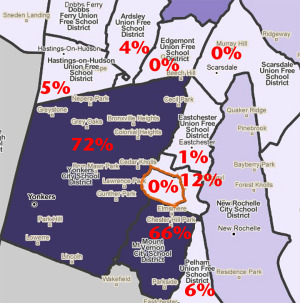Alexander Roberts, executive director of the fair housing group Community Innovations Inc., said he looked for years for a visual representation that showed how exclusionary zoning affects all residents of Westchester County.
He said he found one by creating a map of county school districts with the percentage of students eligible for free or reduced-price lunches in each area.
“If you look at it, it”™s such a blatant example of the social engineering going on in Westchester County,” he said. “There is a history and a philosophy in this country that public education was the great equalizer and this is certainly not the case in Westchester. If you”™re poor, you”™re not likely to be able to be in one of the better school districts.”

Roberts focused specifically on the Yonkers and Mount Vernon school districts, which had 72 percent and 66 percent of their respective student bodies eligible for free or reduced-price lunches. The map was created using PolicyMap, an online data mapping tool, and used numbers from 2011-12 school year recipients and the 2011-12 school year counts of students as reported in the Common Core of Data from the National Center for Education Statistics. The districts directly bordering Yonkers and Mount Vernon had starkly smaller eligible percentages, with Edgemont and Scarsdale”™s public school systems each having zero percent of their student body eligible.
Outside of Yonkers and Mount Vernon, the only other school district with double-digit eligibility was Tuckahoe with 12 percent. Tuckahoe, which serves residents of the village of Tuckahoe and town of Eastchester, is closest to Eastchester and Bronxville”™s public school systems, which have eligibility percentages of 1 percent and 0.2 percent, respectively.
Roberts said equitable public schools would have access for all residents, regardless of race or income. The solution, he said, would be to have wealthier schools absorb some of Yonkers or create larger, more economically diverse districts. “There should really perhaps be a commission to redraw the districts and perhaps consolidate,” he said. “And it could be done with making it more fair for less-wealthy families.”
The idea for the map sprung from the realization that all of New York City had one school district, but Westchester ”” with 11 percent of the population of the city ”” had 48 separate school districts, some of which hover around the 1,000-student threshold identified as being a candidate for consolidation in the 2008 report from the state tax relief commission headed by former Nassau County Executive Tom Suozzi.
The creation of the smaller districts has resulted in gerrymandered school districts, Roberts said, whose boundaries end up locking out those who can”™t “pay in.” Robert Reich, the former U.S. labor secretary, discussed the Orinda, Calif. district”™s efforts in an article for
alternet.org.
“Such schools are ”˜public”™ in name only,” he said. “Tuition payments are buried inside high home prices, extra taxes, parental donations and small armies of parental volunteers.”



















Comments 2